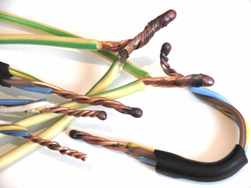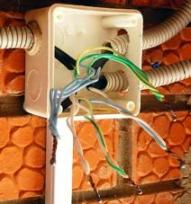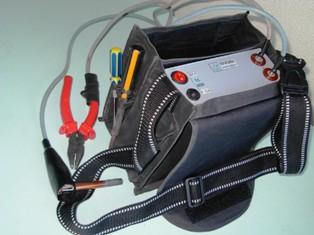Categories: Featured Articles » Electrician Secrets
Number of views: 72784
Comments on the article: 22
Why welding is always better than other wire connection methods
 According to the Rules of Electrical Installations (p. 2.1.21): connection, branching and termination of wires and cables should be carried out using crimpingwelding, soldering or clamping (screw, bolt, etc.) in accordance with applicable instructions.
According to the Rules of Electrical Installations (p. 2.1.21): connection, branching and termination of wires and cables should be carried out using crimpingwelding, soldering or clamping (screw, bolt, etc.) in accordance with applicable instructions.
No matter how convenient (for lazy people) methods of connecting wires, they did not come up with, none of them can be compared with welding in terms of durability and conductivity of the contact. Even soldering is destroyed over time: there is a third, more fusible and loose metal (solder), at the boundary of different alloys there always exists transition resistancedamaging chemical reactions and so on are possible.
The duration and complexity of high-quality soldering is not inferior to welding: thorough cleaning of the ends, the use of fluxes, deep heating of the whole twisting (whereas wire welding usually done in a couple of seconds).
 Various crimps and terminal blocks do not stand any comparison at all. Copper - the main material of conductors - metal is completely inelastic, ductile. It has the ability to "leak" from under the load, even the Grover washers do not help.
Various crimps and terminal blocks do not stand any comparison at all. Copper - the main material of conductors - metal is completely inelastic, ductile. It has the ability to "leak" from under the load, even the Grover washers do not help.
In enough deep spring self-locking terminal blocksas a rule, the area of the effectively contacting surface is too small. At high currents, this leads to heating on the release of these same springs: they lose their elasticity.
After welding, the concept of “contact” disappears altogether: the electric current does not pass through some (even very tightly touching) boundaries of the conductors, but flows through a monolithic metal of the same type. Of course, the resistance of such compounds turns out to be record low, and, accordingly, heat generation practically does not occur (due to the thickening during reflow and the absence of dense insulation, the temperature of the connection at maximum current can even be lower than that of the lead wires).
Welding is carried out at the ends of previously twisted conductors with a carbon electrode using apparatuses with a power of about 500 W (for a twist section up to 25 mm2). Due to the relatively low currents and low (compared with steel) melting temperature, the process occurs without a large blinding arc, without deep heating of materials and spatter of metal. Of course, this does not negate goggles, heat-resistant linings, etc., but all safety measures can be greatly simplified in comparison with power welding.
Coil welding machine
To prevent the oxidation of conductors, a special flux “VAMI” or an ordinary drill is used. It is most convenient to lower the twisted conductors from above into the hole with a flux done in the corner. But some craftsmen perfectly melt the twist with a sharp electrode "on weight".
If after cooling and removing the flux such a compound is varnished and then insulated with PVC tape or a special cap, it will be almost eternal.
See also at e.imadeself.com
:

